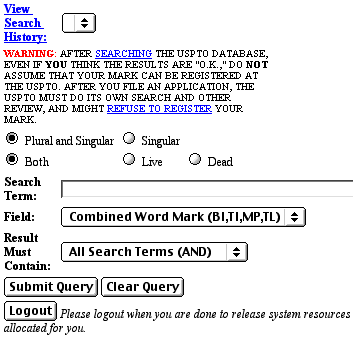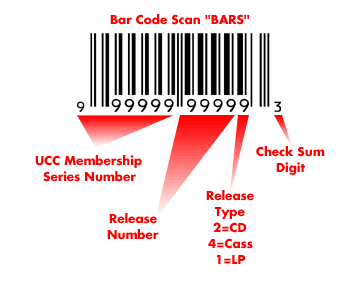Trademark searches are essential for all musicians. It’s probably the first thing you should do before you even begin to record your project or play live shows. Imagine pumping all kinds of effort into your music, your CDs, and your promotion only to find out that someone else thought of (or at least legally owned) your name before you did! In fact, not only could you lose your name, you might even get sued if you tried to use it publicly.
Doing the proper research and registering your name can save you all of these problems. Unfortunately, finding out if someone else already has your name can be very expensive or, at the very least, time-consuming. In fact, most companies that perform trademark searches often charge hundreds of dollars for the service. If you went to your favorite Web search engine right now and entered “Trademark Search” you’d probably get a list of companies like this more than willing to take your money.
Today is your lucky day! MusicBootCamp.com offers you the means of doing your own search absolutely free of charge. We scream and yell the information other companies don’t want you to know. FREE, FREE, FREE TRADEMARK SEARCHES!!! It’s easy, and you can use it as often as you like for any name you can think of. Imagine the peace of mind you’ll feel when you know for a fact that no one else is using your name. What are you waiting for? Go for it!
Anyone who claims rights in a mark may use the TM (trademark) or SM (service mark) designation with the mark to alert the public to the claim. It is not necessary to have a registration, or even a pending application, to use these designations. The claim may or may not be valid. The registration symbol, ®, may only be used when the mark is registered in the PTO. It is improper to use this symbol at any point before the registration issues. Please omit all symbols from the mark in the drawing you submit with your application; the symbols are not considered part of the mark. —US Patent & Trademark Office
When you follow the link provided later, you will see a form that looks like this contained within the page. We recommend you select “live” trademark results. According to our discussion with the US Patent & Trademark Office (USPTO) on this issue, dead trademarks should not prevent a new application from being approved (of course if someone has a pending or live trademark with that name in the same Class you are applying for, you have little chance of obtaining the same mark).

Once you complete your search, you will see a list of relevant results. Click on each of the items that match your desired trademark. On each result page, you will see a section which looks similar to the following excerpt:

In this example, John Doe is the registered trademark. It is registered under International Class #16 (see IC 016). In the music industry, trademark applicants are generally concerned with either IC #9 or #41 because they relate specifically to recordings and entertainment. So in this example, if you found no other live trademarks for John Doe in classes #9 and #41, you stand a good chance of being able to use this name for your trademark as a musical recording and performing artist. Note: we didn’t check all the John Does, so one of them might actually be registered in either of those classes; this is only a hypothetical example.
Perform a FREE Trademark Search! This link connects directly to the US Patent and Trademark Office. It is not a mirror site or a third-party site, so don’t be foolish and pay someone for what you can easily do yourself. Everyone who charges for the service gets their information from this source for free, and now so can you!
If you are in need of additional trademark information not contained on the USPTO Web site or available through their customer services, we recommend you contact an attorney. Important: we are not attorneys. The information listed on this Web site is meant to provide career and business direction. You must confirm any notions you have about this or any other subject with an attorney or with the appropriate agency.
For your convenience, here is the International Schedule of Classes of Goods and Services as listed in “Basic Facts About Trademarks” as published in March 1999 by the USPTO.
INTERNATIONAL SCHEDULE OF CLASSES OF GOODS AND SERVICES
Goods
- Chemicals used in industry, science and photography, as well as in agriculture, horticulture and forestry; unprocessed artificial resins, unprocessed plastics; manures; fire extinguishing compositions; tempering and soldering preparations; chemical substances for preserving foodstuffs; tanning substances; adhesives used in industry.
- Paints, varnishes, lacquers; preservatives against rust and against deterioration of wood; colorants; mordants; raw natural resins; metals in foil and powder form for painters, decorators, printers, and artists.
- Bleaching preparations and other substances for laundry use; cleaning, polishing, scouring and abrasive preparations; soaps, perfumery, essential oils, cosmetics, hair lotions; dentifrices.
- Industrial oils and greases; lubricants; dust absorbing, wetting and binding compositions; fuels (including motor spirit) and illuminants; candles, wicks.
- Pharmaceutical, veterinary and sanitary preparations; dietetic substances adapted for medical use, food for babies; plasters, materials for dressings; material for stopping teeth, dental wax, disinfectants; preparations for destroying vermin; fungicides, herbicides.
- Common metals and their alloys; metal building materials; transportable buildings of metal; materials of metal for railway tracks; non-electric cables and wires of common metal; ironmongery, small items of metal hardware; pipes and tubes of metal; safes; goods of common metal not included in other classes; ores.
- Machines and machine tools; motors and engines (except for land vehicles); machine coupling and transmission components (except for land vehicles); agricultural implements; incubators for eggs.
- Hand tools and implements (hand operated); cutlery; side arms; razors,
- Scientific, nautical, surveying, electric, photographic, cinematographic, optical, weighing, measuring, signalling, checking (supervision), life-saving and teaching apparatus and instruments; apparatus for recording, transmission or reproduction of sound or images; magnetic data carriers, recording discs; automatic vending machines and mechanisms for coin operated apparatus; cash registers, calculating machines, data processing equipment and computers; fire-extinguishing apparatus.
- Surgical, medical, dental and veterinary apparatus and instruments, artificial limbs, eyes and teeth; orthopedic articles; suture materials.
- Apparatus for lighting, heating, steam generating, cooking, refrigerating, drying, ventilating, water supply and sanitary purposes.
- Vehicles; apparatus for locomotion by land, air, or water.
- Firearms; ammunition and projectiles; explosives; fireworks.
- Precious metals and their alloys and goods in precious metals or coated therewith, not included in other classes; jewelery, precious stones; horological and chronometric instruments.
- Musical instruments.
- Paper, cardboard and goods made from these materials, not included in other classes; printed matter; bookbinding material; photographs; stationery; adhesives for stationery or household purposes; artists’ materials; paint brushes; typewriters and office requisites (except furniture); instructional and teaching material (except apparatus); playing cards; printers’ type; printing blocks.
- Rubber, gutta-percha, gum asbestos, mica and goods made from these materials and not included in other classes; plastics in extruded form for use in manufacture; packing, stopping and insulating materials; flexible pipes, not of metal.
- Leather and imitations of leather, and goods made of these materials and not included in other classes; animal skins, hides; trunks and travelling bags; umbrellas, parasols and walking sticks; whips, harness and saddlery.
- Building materials (non-metallic); rigid pipes for building; asphalt, pitch and bitumen; non-metallic transportable buildings; monuments, not of metal.
- Furniture, mirrors, picture frames; goods (not included in other classes) of wood, cork, reed, cane, wicker, horn, bone, ivory, whalebone, shell, amber, mother-of-pearl, meesehaum and substitutes for all these materials, or of plastics.
- Household or kitchen utensils and containers (not of precious metal or coated therewith); combs and sponges; brushes (except paint brushes); brush-making materials; articles for cleaning purposes; steelwool; unworked or semiworked glass (except glass used in building); glassware, porcelain and earthenware not included in other classes.
- Ropes, string, nets, tents, awnings, tarpaulins, sails, sacks and bags (not included in other classes); padding and stuffing materials (except of rubber or plastics); raw fibrous textile materials.
- Yarns and threads, for textile use.
- Textiles and textile goods, not included in other classes; bed and table covers.
- Clothing, footwear, headgear.
- Lace and embroidery, ribbons and braid; buttons, hooks and eyes, pins and needles; artificial flowers.
- Carpets, rugs, mats and matting, linoleum and other materials for covering existing floors; wall hangings (non-textile).
- Games and playthings; gymnastic and sporting articles not included in other classes; decorations for Christmas trees.
- Meat, fish, poultry and game; meat extracts; preserved, dried and cooked fruits and vegetables; jellies, jams, fruit sauces; eggs, milk and milk products; edible oils and fats.
- Coffee, tea, cocoa, sugar, rice, tapioca, sago, artificial coffee; flour and preparations made from cereals, bread, pastry and confectionery, honey, treacle; yeast, baking-powder; salt, mustard; vinegar, sauces (condiments); spices; ice.
- Agricultural, horticultural and forestry products and grains not included in other classes; live animals; fresh fruits and vegetables; seeds, natural plants and flowers; foodstuffs for animals, malt.
- Beers; mineral and aerated waters and other non-alcoholic drinks; fruit drinks and fruit juices; syrups and other preparations for making beverages.
- Alcoholic beverages (except beers).
- Tobacco; smokers articles; matches
Services
- Advertising; business management; business administration; office functions.
- Insurance; financial affairs; monetary affairs; real estate affairs.
- Building construction; repair, installation services.
- Telecommunications.
- Transport; packaging and storage of goods; travel arrangement.
- Treatment of materials.
- Education; providing of training; entertainment; sporting and cultural activities.
- Providing of food and drink; temporary accommodation; medical, hygienic and beauty care; veterinary and agricultural services; legal services; scientific and industrial research; computer programming; services that cannot be placed in other classes.
Click here for an expanded version of the above list.




